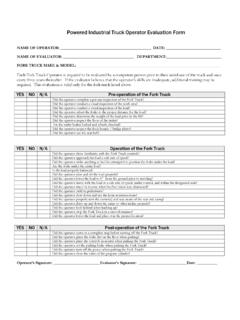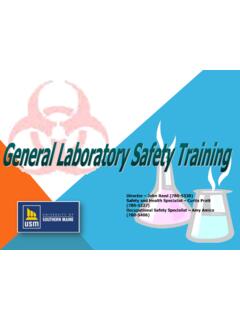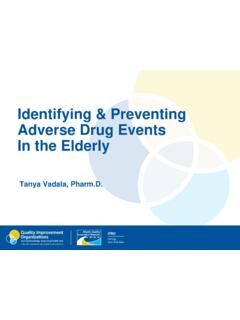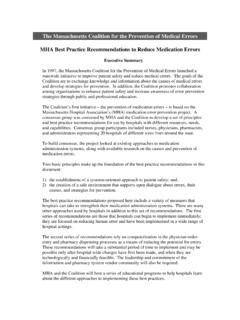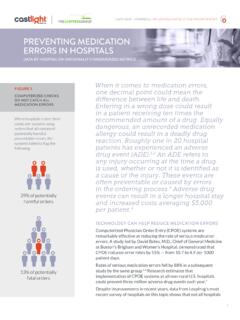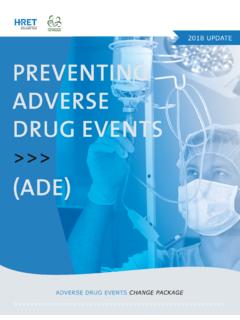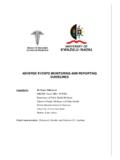Transcription of Patient Safety Academy 2016 9/8/16
1 Patient Safety Academy 20169/8/161 When Medications Hurt: preventing adverse drug EventsRachel Crowe, MPH, BSN, RNDanielle Watford, CMQ OE, MSPatient Safety AcademySeptember 8, 2016 This material was prepared by Healthcentric Advisors, the Medicare Quality Innovation Network Quality Improvement Organization for New England, under contract with the Centers for Medicare & Medicaid Services (CMS), an agency of the Department of Health and Human Services. The contents presented do not necessarily reflect CMS policy. CMSMA_C3 2_010516_0344 Plan for of the New England QIN QIO ProgramOverview of Medication Safety and the National Action Plan Reducing Patient HarmOpportunities for CollaborationBreakout Session9/9/20162 Patient Safety Academy 20169/8/162 New England QIN QIO Led and administered by Healthcentric Advisors in partnership with Qualidigm Healthcentric Advisors: MA, ME, RIQualidigm : CT, NH, VT39/9/ 2016 Primary Goal of the NE QIN QIOI mprove the quality and efficiency of healthcare for all Medicare Beneficiaries9/9/20164 Patient Safety Academy 20169/8/16311th SOW Focus Areas9/9/20165 Cardiovascular Health and Million Hearts InitiativeHealth for Life Everyone with Diabetes CountsMeaningful Use and HITQ uality Reporting and Incentive ProgramsAntibiotic Stewardship and C.
2 Difficile PreventionNursing Home Quality ImprovementSafe Transitions of Care and Medication Safety and adverse drug Event (ADE) Prevention Medication Safety and adverse drug Event Prevention9/9/20166 Patient Safety Academy 20169/8/164 adverse drug Event (ADE)9/9/20167 The National Action Plan for adverse drug Event Prevention US Dept. of HHS Identifies efforts to measure and prevent adverse drug events (ADEs) Patient Safety Prevention of ADE among three primary classes Anticoagulants Diabetes agents Opioids9/9/20168 Patient Safety Academy 20169/8/165 National Action Plan: Anticoagulants Inpatient 10% of drug related adverse outcomes 1/3 of ADEs for hospitalized Medicare beneficiaries Outpatient Among most frequently implicated drug classes in ADEs that contribute to ED visits and admissions Driver for ADE related hospital readmissions Long term Care Settings Common cause of preventable harm ~34,000 fatal, life threatening, or serious warfarin related ADEs per year in nursing home settings9/9/20169 National Action Plan.
3 Diabetes Agents Inpatient Hypoglycemia is third most common ADE nearly all of which are preventable Insulin implicated in 33% of medication error related deaths Outpatient Among top medications classes resulting in emergent hospitalizations for ADEs From 1999 2010, hospitalizations for hypoglycemia increased by almost 23% Long Term Care Settings Approximately 34% of residents have Type 1 or Type 2 diabetes and possess primary risk factors for ADEs (advanced age, recent hospitalization, and polypharmacy)9/9/201610 Patient Safety Academy 20169/8/166 National Action Plan: Opioids Number of prescription opioids dispensed doubled between 1999 and 2010 Opioid analgesics are one of the top classes of prescribed medications overall Prescription opioid related deaths are considered to be one of the Nation's leading preventable public health problems9/9/201611 Health System Related ADE Implications1/3 of hospital adverse events 1280,000 hospital admissions annually 1 One quarter of all ADEs are preventable 3 The CDC estimates that $ billion is spent on extra medical costs associated with ADEs every yearHospital admissions related to ADEs in adults > 65 years was Department of Health and Human Services, Office of Disease Prevention and Health Promotion.
4 (2014). National Action Plan for adverse drug Event Prevention. Washington, : Koh, H. 2 Bourgeois FT, Shannon MW, ValimC, MandlKD. adverse drug events in the outpatient setting: an 11 year national analysis. Pharmacoepidemiology and drug Safety . September 2010;19(9):901 , Corbett C. Prevention of Medication Errors in the Older Adult Patient . Postgraduate Healthcare Education, LLC. Power Pak Mylan Pharmaceuticals, 2013. 12 Patient Safety Academy 20169/8/167 Patient Related ADE Implications Loss of Patient productivity Increased healthcare costs Decreased quality of life9/9/201613 Reducing Patient HarmSurveillancePreventionIncentives and OversightResearch9/9/201614 Patient Safety Academy 20169/8/168 ADE Surveillance Importance Quantify the scope and magnitude; identify new or previously unrecognized issues Basis for measuring progress Inform future program development or policy revision Considerations Active vs.
5 Passive Surveillance Actual Harm/Injuries vs. Potential Problems/Med Errors9/9/2016159/9/201616 Patient Safety Academy 20169/8/169 Prevention9/9/201617 Patient & Family Engagement Awareness, readiness and education Standardized care processes Decision support Safe transitions of care Prevention of failureIncentives and Oversight9/9/201618 Research Explore opportunities within existing Safety and quality programs, measures and payment models Identify current knowledge gaps and future research needsPatient Safety Academy 20169/8/1610 QIN QIO Program Requirements:Primary Goal: Improve medication Safety and aim to reduce and prevent ADEs Implement evidence based and proven best practicesPopulation of Focus: Medicare FFS patients 3 or more medications At least one CMS identified high risk medication Anticoagulant Diabetic Agent Opioid9/9/201619 Achieving Our GoalsImprove Medication Safety and Reduce ADEsScreen patients for ADEs and pADESD evelop partnerships & collaborations within communityPromote evidence based / proven best practicesImplement new tools / build upon existing tools9/9/201620 Patient Safety Academy 20169/8/1611 Opportunities for CollaborationProvide analytic support and review of shared data as well as technical assistance to help identify areas for possible QI initiativesHighlight role of the pharmacist intervention in the prevention of unnecessary healthcare utilizationProvide platform to share and discuss your work with thought partners locally.
6 Regionally and nationally Identify opportunities for participation in community coalitions Partner together to identify potential areas to improve medication Safety and adverse drug event preventionIdentify ways to support current work and help add additional value (analytic support, claims data, educational sessions, tools and resources) Identify surrogate measures to help track, monitor and report medication Safety related data (recommendations pADES vs. ADEs; lab values INR, glucose; antidotes Vitamin K, glucagon, naloxone)Using QIN QIO claims data and ICD 9 and 10 codes to report and reduce utilization associated with anticoagulants, diabetic agents and opioids 9/9/201621 Breakout Safety Academy 20169/8/1612 Lessons Learned Many medication Safety related initiatives underway across the region Limited focus on tracking and monitoring of ADE data from the provider and system level Lack of communication between pharmacists in practice settings Limited capacity for pharmacists to get involved Align efforts to improve efficiencies and reduce duplication Continue to partner and develop relationships at the provider level Processes and approaches will continuously evolve as we continue to learn more and move forward 9/9/201623 Questions?
7 Contact Information9/9/201624 Medication Safety Program Coordinator:Rachel Crowe, MPH, BSN, RN Home Program Coordinator:Danielle Watford, CMQ OE, MS




